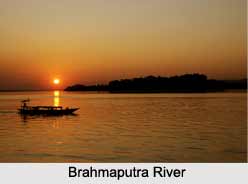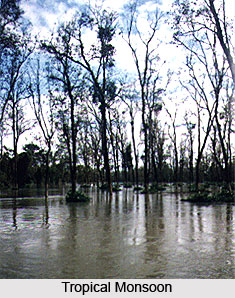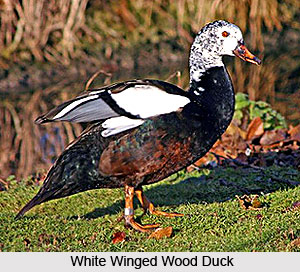 The largest wildlife preserver in Assam, the Dibru-Saikhowa National Park and Biosphere Reserve is situated on the alluvial flood plains of Brahmaputra in Upper Assam. The park covers a vast area of 650 sq km and situated only 13 kms away from the Tinsukia town. It is bounded by the Brahmaputra River and Arunachal Hills in the north and Dibru and Patkai Hills on the south. The park was declared as a wildlife Sanctuary in 1986 by the State Government of Assam. The Government united two Reserve forests, named Dibru and Saikhowa and included some other areas and established this National Park and Biosphere Reserve. The Government of India elevated the park to National Park, in the year 1999. The core area of the park is spread over 340 sq km. and it has a large buffer zone, as well. Dibru-Saikhowa National Park and Biosphere Reserve provides natural habitat to a large variety of flora and fauna species.
The largest wildlife preserver in Assam, the Dibru-Saikhowa National Park and Biosphere Reserve is situated on the alluvial flood plains of Brahmaputra in Upper Assam. The park covers a vast area of 650 sq km and situated only 13 kms away from the Tinsukia town. It is bounded by the Brahmaputra River and Arunachal Hills in the north and Dibru and Patkai Hills on the south. The park was declared as a wildlife Sanctuary in 1986 by the State Government of Assam. The Government united two Reserve forests, named Dibru and Saikhowa and included some other areas and established this National Park and Biosphere Reserve. The Government of India elevated the park to National Park, in the year 1999. The core area of the park is spread over 340 sq km. and it has a large buffer zone, as well. Dibru-Saikhowa National Park and Biosphere Reserve provides natural habitat to a large variety of flora and fauna species.
Dibru-Saikhowa National Park and Biosphere Reserve is one of the 19 biodiversity hotspots in the world. The park is located at an altitude of 118 metres above the sea level. It lies between 27 degree 30 minutes north to 27 degree 45 minutes north latitude and 95 degree 10 minutes east to 95 degree 45 minutes east longitude. The average altitude of Dibru-Saikhowa National Park is 118 metres above the mean sea level. Biogeographically the area exhibits the properties of both Indian and Malayan sub regions and represents the north eastern region of India and Brahmaputra valley bio-geographical province. Situated in the flood plains of Brahmaputra, Dibru-Saikhowa is a safe haven for many extremely rare and endangered species of wild life.
 Dibru-Saikhowa enjoys a tropical monsoon climate with a hot and wet summer and cool and usually dry winter. The annual rainfall varies from 2300 mm to 3800 mm. The major rainy months are June, July, August and September. The annual temperature of the area ranges from 7 degree Celsius to 34 degree Celsius where June, July and August are the hottest while December and January are the coolest months.
Dibru-Saikhowa enjoys a tropical monsoon climate with a hot and wet summer and cool and usually dry winter. The annual rainfall varies from 2300 mm to 3800 mm. The major rainy months are June, July, August and September. The annual temperature of the area ranges from 7 degree Celsius to 34 degree Celsius where June, July and August are the hottest while December and January are the coolest months.
Natural vegetation in the Dibru-Saikhowa National Park and Biosphere Reserve is principally comprised of semi-evergreen forests, deciduous forests, littoral and swamp forests and patches of wet evergreen forests, bamboo, cane brakes and grasslands. A great variety of Orchid also blossom in the park. Being an ideal habitat for many animals and birds, the park is counted amongst the most vibrant wildness on earth. It is distinct for its pristine scenic beauty. The main species of the Orchid flora found in the park include Salix tetrasperma, Bischofia javanica, Dillenia indica, Bombax ceiba, Terminalia myriocarpa, Lagerstroemia parviflora, Mesua ferrea, Dalbergia sissoo, Ficus spp. etc. The species like Arundo donax, Imperata cylindrica, Phragmaties karka, Erianthus ravanea, Saccharum spp. are some of the dominant species of grasses in the National Park.
The park was primarily established for conserving the White-Winged Wood Duck in its natural habitat. However, the park later became famous for its Bright Coloured Wild White-Winged Wood Duck Horses, also known as Feral Horses. Almost 36 species of mammals have been recorded so far. Some of the most important mammal species found in the park include the Royal Bengal Tiger, Leopard, Clouded Leopard, Jungle Cat, Sloth Bear, Dhole, Small Indian Civet, Malayan Giant Squirrel, Chinese Pangolin, Gangetic Dolphin, Slow Loris, Pig Tailed Macaque, Assamese Macaque, Rhesus Macaque, Capped Langur, Hoolock Gibbon, Asian Elephant, Wild Boar, Sambhar, Hog Deer, Barking Deer, Asiatic Water Buffalo, etc.  Apart from these, the reptiles species found in the park include 2 species of Monitor Lizards, 8 species of Turtles and 8 species of Snakes. 62 different species of fishes have been recorded from the Dibru-Saikhowa National Park and Biosphere Reserve, as well.
Apart from these, the reptiles species found in the park include 2 species of Monitor Lizards, 8 species of Turtles and 8 species of Snakes. 62 different species of fishes have been recorded from the Dibru-Saikhowa National Park and Biosphere Reserve, as well.
Besides, the rich variety of natural vegetation and mammal fauna species, the Dibru-Saikhowa National Park and Biosphere Reserve is also home to more than 350 species of birds. The bird species are of both resident and migratory types. The local and migratory birds found in the numerous water bodies of the park include the White Winged Wood Duck, Bengal Florican, Great East Indian Hornbill, East Indian Pied Hornbill, Spot Billed Pelican, Greater Adjutant Stork, Lesser Adjutant Strok, Greater Spotted Eagle, Swamp Fran Colin, Blyth`s Kingfisher, Great Grebe, Indian Shag, Grey Heron, Purple Heron, Night Heron, Yellow Bittern, Open-bill Stork, Black Stork, Large Whistling Teal, Griffon Vulture, Osprey, Crested Serpent Eagle, March Babbler, Jardon`s Babbler, Black Breasted Parrot-bill, etc. This park has 79 feral horses.
Apart from being a protector and conserver of the great variety of wildlife in the region, the Dibru-Saikhowa National Park and Biosphere Reserve is also considered as a favourite tourist destination. Several tourists from throughout India and also from all over the world come and visit the park, on a regular basis. A written permission from the Park Authority is required for entering into the park and Guijan Ghat and Saikhowa ghat are the two entry points for the tourists. Moreover, entry after sunset and before sunrise is not permitted. The park is generally open for the tourists during the months of November to April or as notified by the National Park Authority. Night halt inside the park is strictly prohibited. Dibru-Saikhowa National Park is well connected by airways, roadways and railways. Tinsukia is the nearest town to this national park. Dibrugarh is the nearest airport which is about 40 km away from Tinsukia Town. Dibru-Saikhowa National Park attracts a number of tourists from different parts of the world every year.



















